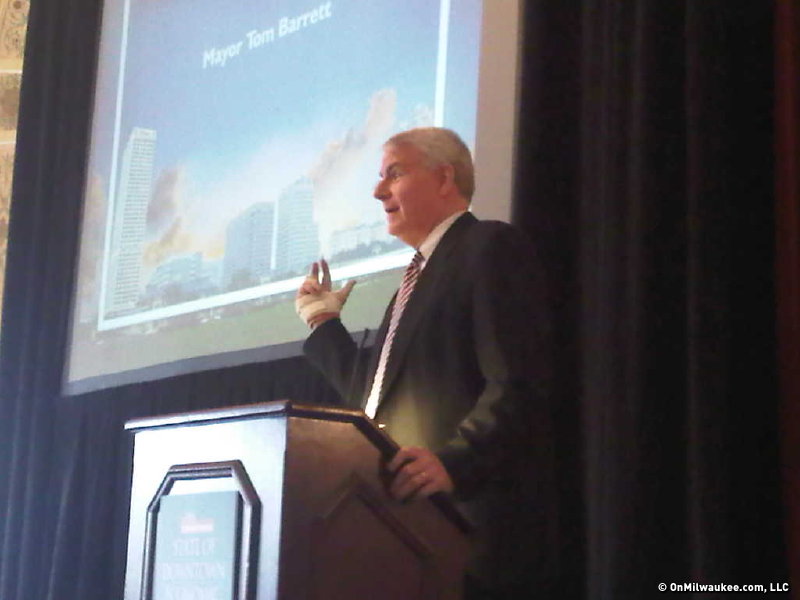{image1} There is an old chestnut that says you can still buy touch-up paint for avocado green and harvest gold appliances at Milwaukee hardware stores because so many people loathe change.
But there is plenty of change in store for Milwaukee -- not only with the election of Mayor Tom Barrett, but with a new police chief who is revamping the department like a homeowner with a vision for the ramshackle home she bought for $1. Chief Nannette Hegerty's mission is not so much one of historical preservation as it is one of crafting a 21st century police department that likely will make her a chief with a positive legacy -- in stark contrast to those left by former Chief Harold Breier and others -- legacies that left scars on communities and scorched earth in their wake.
The making of this legacy are here:
Change is coming to the city in the form of a more professional police force -- one policed not by the soon-to-be-phased-out Internal Affairs Division, but by the new Professional Performance Division. Under Hegerty's department reorganization plan, presented recently to the city's Fire and Police Commission, the new division will better spend its time emphasizing best practices and watching out for cops who should be red-flagged because of questionable behavior, rather than walk behind the elephant with the broom and bucket. Hegerty has moved swiftly in ferreting out those officers who are not with the citizens of Milwaukee; note her immediate transfer of a popular district captain who posted a scathing memo to his officers referring to some residents as "thugs."
In keeping with Hegerty's commitment of community involvement, the University of Wisconsin - Milwaukee will be involved in sketching out how the new division will operate from an academic point of view. The days of spotty officer accountability are over with Hegerty on point.
In a community often inured to bad cop behavior of the past, Hegerty has proposed cultural competency training -- not just a fancy way of saying "diversity training" -- but a course model set up to address the city's emerging Asian population and to continue to improve on interactions with the existing minority populations of African Americans and Hispanics. Milwaukee's minority community has become the majority population in the city, and it is way past the time for the Milwaukee Police Department to address it so it can be effective with all the city's populations. Hegerty came in door with this realization, and unlike her predecessors, she is turning her ideas into substantial attitude change.
Disenfranchised communities are being brought into the fold with Community Crime Analysis meetings held monthly at all seven police district stations. At District Two, which serves a predominantly Hispanic population, the meetings are in Spanish. The meetings are created for police district captains, community leaders, residents and politicians. Some inside the department say the politicians could do a better job of showing up for these conclaves, and they would be wise to make inroads with the new chief. Hegerty and her commanders spend a good amount of time meeting with community groups and even speak at Sunday church services to maintain their contacts and build relationships instead of waiting for bad things to happen and then trying to rally support.
And support is building for Hegerty within the ranks as she brings back crime fighting tools that actually worked -- the Gang Crimes Unit, for one. Arthur Jones eliminated the unit, whose officers gathered intelligence on gang activity and provided leads to detectives investigating homicides, robberies and a host of other crimes. Cops are starting to feel like it's OK to do police work again, without worrying about things like whether they have their hat on while writing up a traffic accident.
Even the media has taken notice of a new and improved Milwaukee Police Department, although many are too young to remember the days of a non-existent public information system under former Chiefs Breier and Jones.
Reporters of today know nothing of police commanders who hang up on them when queried about a homicide. Few remember the days when officers at a crime scene turned their backs on a reporter they did not know, or even, occasionally on those they did. Some reporters are "seasoned" enough to remember when a press room was set up for those on the cop beat right in the Police Administration Building, only to see former Police Chief Arthur Jones get rid of it like so much annoying trash. Hegerty has put a system in place whereby reporters have a public information officer to call for news updates -- officers who are authorized to release previously elusive information and to appear on television for the coveted soundbites.
Hegerty's most notable "first" actually is not that she is the first female police chief, but she is the first in decades to set up shop in the chief's office and actually roll up her sleeves. Her watchwords are "professionalism" and "it's a new day in the Milwaukee Police Department," but she doesn't use them as bumper sticker politics. They are her tenets, her guidebook, and they are finding their way into the lexicon of Milwaukee's police officers. She already has met with Barrett, and the two seem poised to work together, rather than in their respective fiefdoms as has been the customary coexistence between chiefs and mayors of the past.
Hegerty appears to be well on her way to setting the standard by which subsequent chiefs will be judged -- chiefs who may come from the very ranks she is training today.
-Schwartz is a Milwaukee writer and author. As a television and newspaper reporter she covered the Milwaukee Police Department for more than a decade.







